Passionflower: types, planting and home care
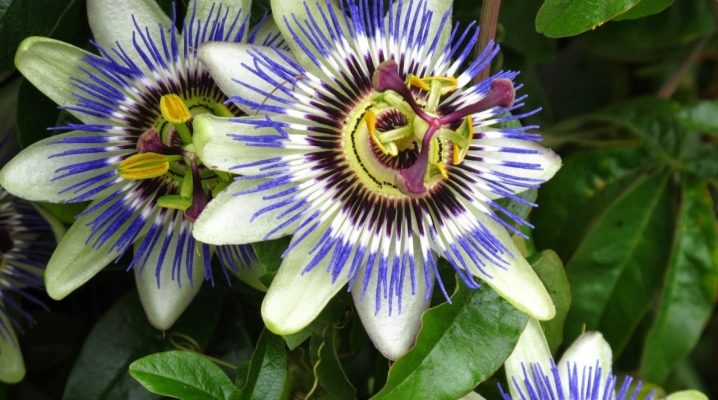
Passionflower is very popular among flower growers and lovers of exotic plants. She attracts many with her luxurious flowers and uncomplicated appearance. An interesting fact - the fruits of the plant are very tasty and have medicinal properties, we know them under the name of passion fruit. Before growing a plant at home, you need to familiarize yourself with all the intricacies of care.
What it is?
Passionflower is a herbaceous plant. It can also appear as an evergreen shrub with twisting vines. You can often find another name - passion flower. It can be either an annual plant or a perennial.
Description of passionflower.
- The shoots of the plant have a woody structure.
- Passionflower leaves are painted in a rich green color. They can take lobular or whole forms.
- Large axillary flowers bloom on the stem of the passionflower. They take on the shape of a star, painted in a variety of bright colors.
- In diameter, the flower can reach as much as 10 centimeters.
- Flowers consist of five petals, the same number of sepals. The cover sheet is quite large. The center of the flower consists of an ovary with three stigmas. The ovaries of the plant are surrounded by five stamens, which have large anthers.
- Passionflower is famous for its wonderful aroma, but wilting occurs relatively quickly in most species. Passion flower is considered to be in bloom in July. The plant bears inflorescences until October.
- The fruits appear immediately after flowering. Their length can be 6 centimeters.
Lianas, which have lush flowers, which can also be grown indoors, have one very rare feature.
The plant has edible fruits. This is the well-known tropical passion fruit. As surprising as it sounds, it can be easily grown at home.
The sizes of the fruit are varied, at most they can reach 15 centimeters in diameter and weigh about 2 kilograms. In some varieties, the fruit can reach 5 kilograms. Florists fell in love with passion flower for its unpretentious care and beautiful appearance.
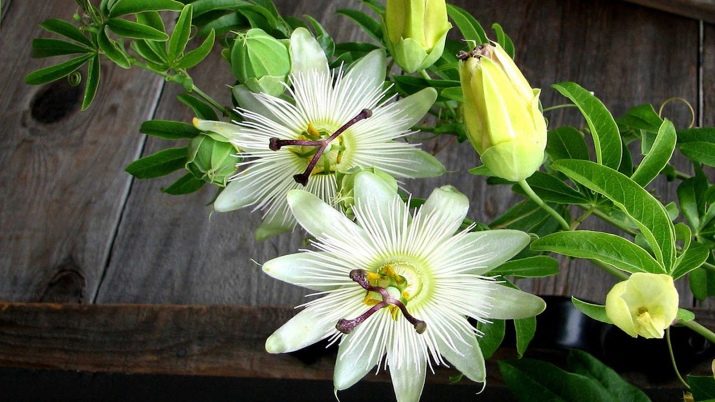
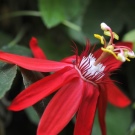
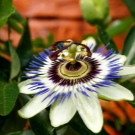
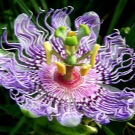
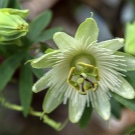
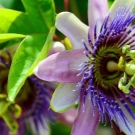
Varieties
There are many types of passion flower, we bring to your attention a list of the most popular plants.
- Passionflower blue. South America is considered the birthplace of this plant species. In the spring period, a violent flowering begins, which continues until autumn. The flowers can range in diameter from 5 to 10 centimeters. They are usually colored blue and less often white. There are also hybrids of this variety of passionflower. Their flowers are larger and have a purple color. In some cases, they are cream colored. The plant can reach a height of about 9 meters. Passionflower fruits are yellow in color and resemble a hen's egg in shape.
Many housewives add them to apple charlotte. In care, such passionflower is quite unpretentious and can adapt to any conditions. The advantage of the plant is frost resistance.
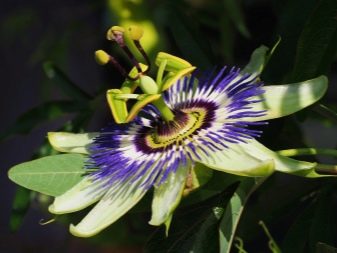
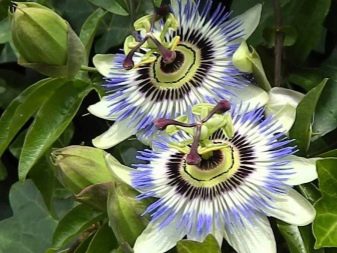
- Passionflower is edible. The plant arrived in our region from distant Brazil. Locals call it "crimson granadilla". Representatives of this species have twisting vines and bare shoots. Glossy leaves consist of three lobes, serrated at the edges. The flowers are white, and their diameter can be 5-7 centimeters.Passion flower stamens are colored purple. Usually the fruit is yellowish-green in color, in some cases dark purple. The shape of the fruit is ovoid. The plant bears its first fruits in the second year after sowing.
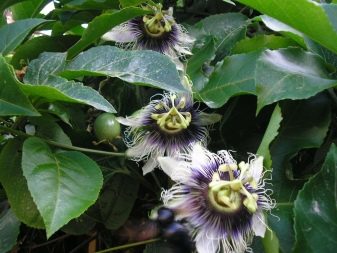
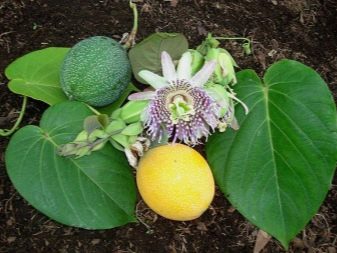
- Passionflower incarnate (meat-red)... The natural habitat is the central and northern parts of South America. The plant grows to a height of 10 meters. The petioles on the stems are oblong. The stems themselves are smooth, the same can be said about the leaves. The flowers are small, and their color palette can be varied. In this case, the purple color predominates. The fruits of the plant have a pleasant taste, and they are colored yellow.
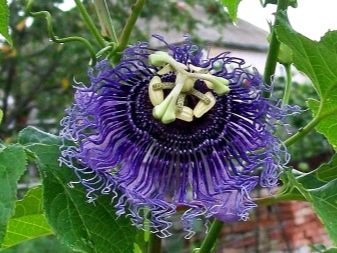
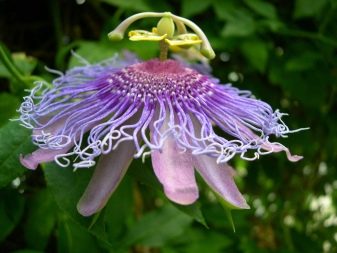
- Passionflower "Royal Star". Representatives of this species grow rather quickly. A characteristic feature of this passion flower is the persistent aroma and long flowering of the plant. They serve as an excellent decorative element for both the garden and the home. The flower in most cases is colored white or blue, its diameter can reach 10 centimeters. The fruits are yellow in color, and their shape resembles a hen's egg. This passionflower is easy to care for and is suitable for growing in pots. The height of a houseplant can be up to 0.3 meters.
Also, the plant adapts well to cold weather.

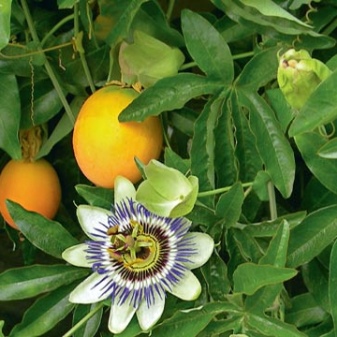
- Passionflower "Maestro"... The plant is considered perennial and grows up to 4 meters in length. The shoots are also usually very long; the presence of antennae helps them to catch on to the support. Leaves differ in their large size and are divided into 3-5 lobes. The fruits are edible and quite tasty, often this type of plant is grown as a fruit. Passion fruit and granadilla are considered the most popular passionflower varieties.
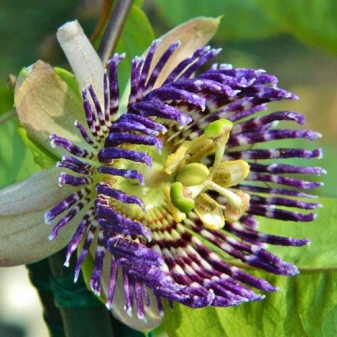
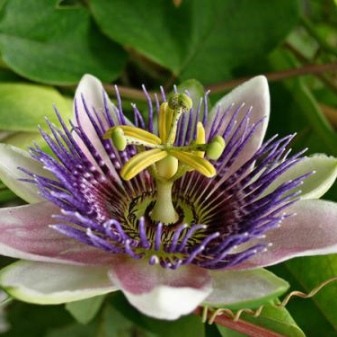
- Passionflower "Alata Red". The value of this plant is expressed not only in decorative accessories, but also in food. The shrub can grow up to 9 meters in height, after which juicy fruits appear on it. Passionflower flowers are large enough, their diameter can be up to 10 centimeters. Their base is painted in burgundy, and the core, consisting of villi, has a lilac color.
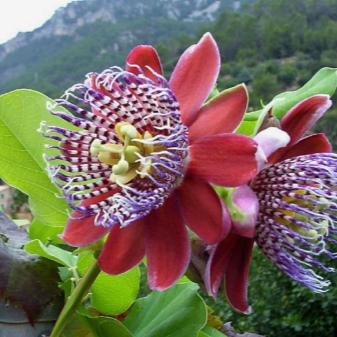

- Passionflower "Cassiopeia". Unlike previous varieties, this passionflower does not have edible fruit varieties. They appear after flowering and are yellow in color. Flowers usually have a deep blue tint, and their diameter can reach 12 centimeters. If you want to grow such a flower, then it is best to stock up on special high supports, since passionflower vines are very long and they need to cling to something. Exuberant color falls in the spring and lasts until the coldest days.
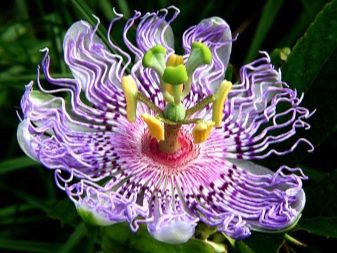
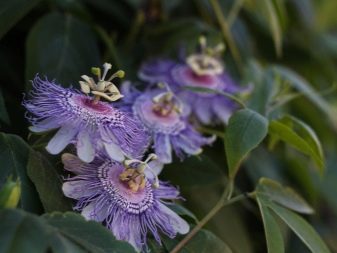
- Giant passionflower... The habitat of this species is South America. Liana is an evergreen plant that has a tetrahedral shape. Passionflower flowers are quite large (10 centimeters in diameter), bell-shaped. The outer side of the flower has a rich red hue. The inside is usually white. Fruits are oblong, colored yellow with green tints. This variety can adapt to any conditions.
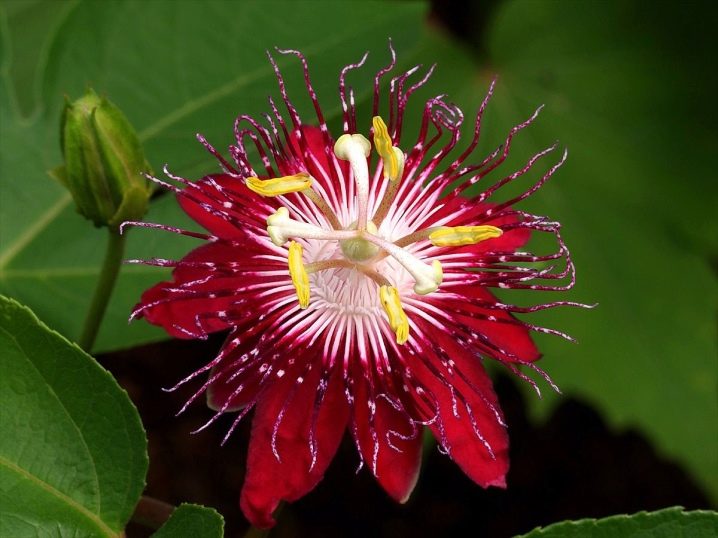
- Reed passionflower. Usually this variety grows in the mountains of the South American continent. Vines grow very quickly, their maximum length can reach 4 meters. The wide leaves have a smooth surface, their length varies from 7 to 10 centimeters. The flowers are also impressive in size, they are painted in a pale pink hue. After a period of active flowering, the plant bears small fruits. They are yellow. In some cases, there are orange fruits.
In order to stimulate the growth of a plant, it is necessary to grow it in conditions of high humidity, and the temperature should be at least +18 degrees.
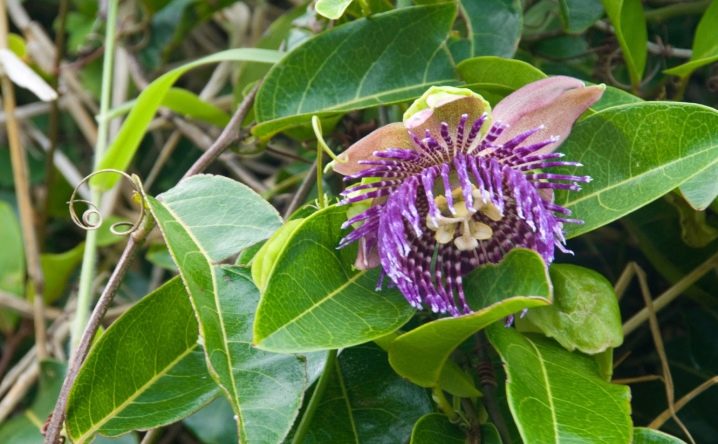
- Passionflower edulis. The flower, like many of its relatives, is distinguished by the presence of a long liana, which grows up to 10 meters in length. There are small flowers that are three centimeters in diameter, and they are colored purple. After the plant has faded, the edible fruit appears in the form of passionfruit, which has many beneficial properties.
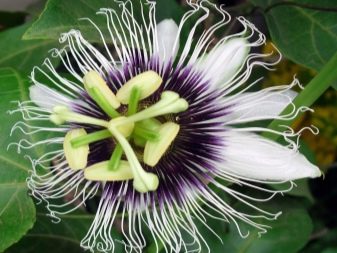
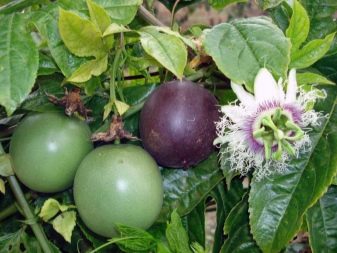
- Passionflower "The Bat". It is considered one of the rarest representatives of passionflower. The leaves are shaped like the wings of a bat. The flowers of the plant are small in size (up to 3 centimeters in diameter), they are colored yellow. The plant also has edible fruits, which, by the way, are very tasty. They are painted purple. Adapts well to room conditions.

Conditions of detention
Passionflower, like many other plants, requires an individual approach due to its characteristics. In order for passionflower to develop normally, it is necessary to adhere to some rules for its content.
Lighting and placement
Passion flower is best placed in a lighted place, as it likes direct light. It is strongly not recommended to grow the plant in shaded areas. It is also necessary to create conditions for sufficient moisture in the soil. The same goes for air. Thus, you can create a favorable microclimate. The eastern and western parts of the house are best illuminated, so it is necessary to choose windows with such an arrangement. A light shade is acceptable for the plant, but in this case, the flowering will not be intense. Airing is also beneficial for the plant.
In summer, it is recommended to take passionflower out into the yard or on the balcony. It is better to find a place that is warm and sunny. It is also important to take into account the fact that in the cold season, the plant experiences a deficiency of sunlight, which eventually gets used to. Therefore, with the onset of warmth, it is better to gradually accustom the passionflower to an increased level of lighting. Otherwise, the plant may get burned. In winter, plants should be fed with additional light sources, for example, using a table lamp.
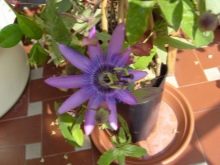

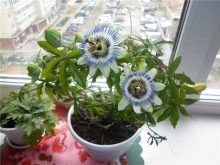
Temperature and humidity
From time to time, it is recommended to spray the passion flower with water at room temperature. In winter, the plant needs such care under warm winter conditions, as well as if the air in the house is dry. To increase the moisture level, special ingredients are added to the pot tray. It can be any porous material, for example, wet expanded clay or peat. It is also important that the bottom of the pot does not come into direct contact with water. If the air is not saturated with moisture, then this can lead to various diseases. This situation can provoke the fall of the inflorescences.
In the warm season, it is best to grow the plant in temperatures from +20 to +25 degrees. In winter, passionflower adapts perfectly to the coolness and requires a temperature of +13 to +18 degrees to keep it.
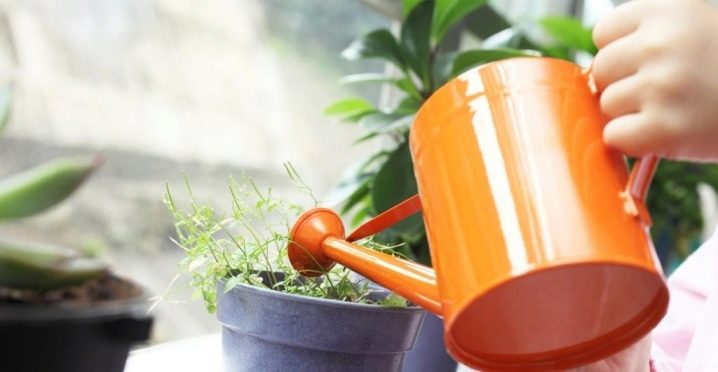
Landing
The main advantage of passionflower is that absolutely any soil is suitable for planting it. To plant a flower, professional growers usually prepare a special mixture by mixing several types of soil, from which a rather soft and fertile soil is obtained:
- peat;
- leafy land;
- sand;
- sod land.
In some cases, you can purchase a ready-made special composition designed for begonias.

It is not recommended to deeply bury the seedling in the ground, because this will slow down the growth of the passion flower. After planting, cover the seedling. A small jar is perfect for this purpose. You can also design a small greenhouse arch. It should be removed only a couple of weeks after planting. It is recommended to ventilate the plant at least once a week. Drainage should be laid out at the bottom of the pot, which can be purchased at any specialty store.
In order to grow passionflower as a perennial plant, it is recommended to transplant at least once a year.
Spring is best. Before transplanting, it is necessary to trim the shoots of vines by about 1/3 of their length.
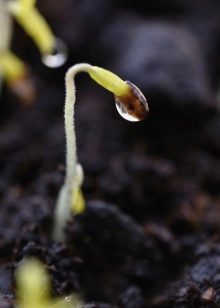

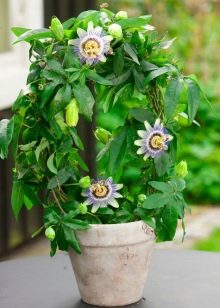
How to take care of it properly?
In its natural environment, passionflower is prone to very rapid growth, but at home its growth slows down somewhat. This can be avoided by taking proper care of the plant.
Watering
Due to its growing area, passion flower loves moisture and needs abundant watering. It is also recommended to increase the moisture level in the air. Watering the plant several times a week is necessary in the warm season. As for the winter season, it is recommended to reduce the number of waterings. In the evenings, the plant should be sprayed with water at room temperature. In the heat, you can water the plant with a shower.
But this must be done very carefully, since any wrong movement can easily damage the stems of the passion flower.

Top dressing
This process takes place from early spring to early autumn. It is recommended to feed passionflower at least three times a month. Any organic feed is ideal for this. Also, many gardeners often resort to the use of mineral complexes. Water the plant before feeding, otherwise dry roots may be affected by the fertilizer.

Pruning
One year after planting passionflower, the plant will already be fully formed and ready to be pruned. This process is mandatory and should be done no more than once a year. Spring is considered the most favorable period for pruning passionflower.
The pruning process involves a set of mandatory steps.
- Strong shoots must not be cut off.
- Compulsory pinching of young shoots.
- Branches that are at the base of the stem are subject to pruning. The same applies to the apical branches.
- Mandatory removal of withered branches is required.
- It is recommended to treat the areas affected by pruning with a special tool - potassium permanganate is usually used.
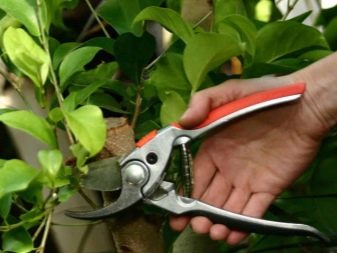
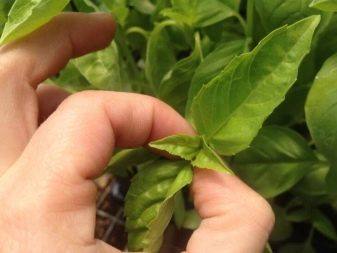
Reproduction
Like many other plants, passionflower can reproduce in two ways.
Propagation by cuttings
In the spring, the passion flower has new shoots, then it is recommended to cut them off. It is necessary to measure five centimeters from the bud of the plant and cut off only the middle shoots. Choose cuttings that have a few small leaves on the surface. It is recommended to treat the cut of shoots with any means intended for the effective formation of the root system. At the next stage, we take a small container and fill it with drainage.
A specially prepared soil mixture can be poured over the drainage. It is necessary to make holes in it for cuttings. A small number of leaves on the shoot should be concentrated at the same level with the ground. After planting, the plant needs to be watered and a small greenhouse should be made for it, covering it with a special film. It is removed every week to ventilate the plant. The plant takes root only under the condition of moist soil and the required temperature (+20 degrees). The greenhouse cover is removed within 30 days after planting. When the root system is fully strengthened, the passionflower can be transplanted.
The rooting process can also take place in water. Nothing unusual is needed for this. The cuttings are simply dipped into the water and lie there until the root system begins to form.
Features of rooting passionflower cuttings at home are given below.
Propagation using seeds
March is the most suitable time for planting. Seeds from my own plant have a very poor germination rate, so it is recommended to buy them in specialized stores. Before the sowing process, the seeds need scarification.This process violates the integrity of the shell, which in the future will allow the passion flower to germinate faster. To carry out this process, you can take sandpaper.
Next, you need to take a small container, put the seeds there and fill them with milk. In some cases, orange juice can also be used. Seeds that have floated to the surface should be thrown away, since nothing will germinate from them. After the seeds have absorbed the liquid, they are pressed into the prepared, moist soil. After disembarkation, the container is covered with any material and placed on a well-lit windowsill. The optimum temperature for normal germination is + 22-25 degrees. The cover can be removed after the first shoots appear in the container. To strengthen the plant, it is transplanted into renewed soil.
This should be done after the appearance of the first leaves. This method is considered to be quite lengthy, since seedlings can appear only a year after sowing.
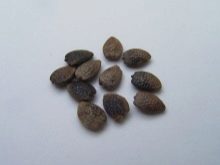

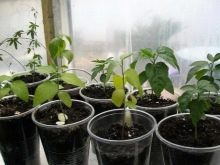
Diseases and pests
Passion flower is very fond of moisture, but one should take into account the fact that if the plant is heavily flooded, it can get sick. In this case, a fungal disease is especially dangerous for him. It manifests itself in the form of spots on the leaves of the plant, after which the passion flower begins to fade. Prevention of treatment is dry keeping. It also needs to be treated with a special fungicide-based agent.
If the flower is improperly moistened, the root begins to decay rapidly. In this case, it is recommended to cut off the shoots and replant the finished cuttings. If the trunk is rotten, then it is better to cut off the remaining healthy parts and re-breed the plant with cuttings.
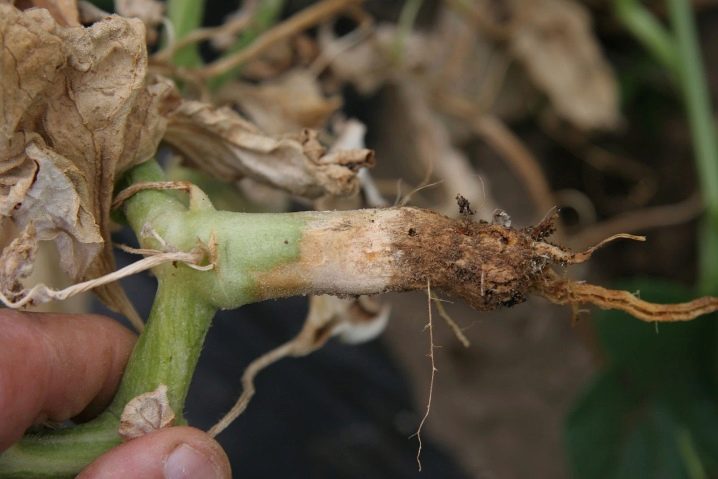
Passionflower has very succulent leaves. This usually attracts various pests. If the parasites have reached the plant, then it begins to fade and lose its former appearance. To get rid of them, you should use a soapy solution. Many people use insecticide-based preparations.
There are also infectious diseases that subsequently lead to the death of passionflower, among them are:
- root rot;
- scab.
In case of infection, passionflower must be disposed of, otherwise other plants may also get sick.
If a plant loses its former attractiveness, then this does not always indicate the presence of a disease. Often the plant does not have enough watering or temperature conditions are not suitable. If the buds do not open, then the plant is overtaken by a lack of various nutrients, and in this case, passionflower requires feeding.
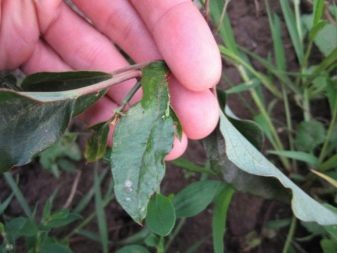
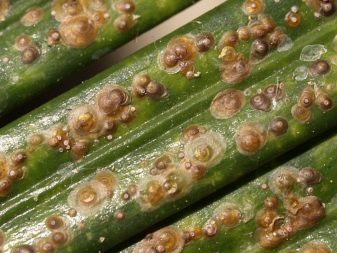
For information on how to keep passionflower at home in winter, see below.























The comment was sent successfully.